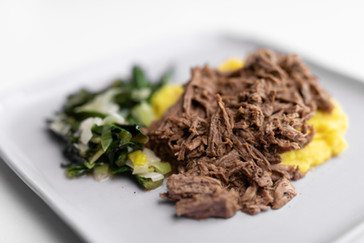Why Eating Local Matters When You Have Histamine or Mast Cell Issues
- histaminehavenmave
- Oct 13
- 4 min read
And why we’re excited to introduce a beef option that’s low in histamine

Eating local food is one of the most supportive choices you can make—especially if you’re living with histamine or mast cell mediated symptoms.
Local food is often fresher, more nutrient-dense, and less processed than its store-bought counterparts. And when it comes to histamine, freshness matters.
Histamine builds in food over time, especially in animal products and anything stored, transported, or aged for long periods. When your food comes from nearby, there’s less time between harvest or processing and your plate—which can mean a noticeably lower histamine load.
But the benefits of eating local go beyond freshness. You’re also:
More connected to how your food is grown or raised.
In sync with your environment and seasonal rhythms.
Supporting producers who often use gentler, more transparent methods that align with your body’s needs.
All of this can make local food not only easier to tolerate, but more satisfying on every level—from digestion to energy to radiant skin to immune function.
That’s why we’re excited to share something quite special. We recently spoke with a local beef producer who has created a delicious, low-histamine beef option—without the aging process that typically makes conventional beef problematic for sensitive systems. Read on for more!

Local Food = Lower Histamine Load
One of the primary reasons histamine levels rise in food is time. The longer food sits—during storage, shipping, or processing—the more histamine has a chance to form, particularly in high-protein foods like meat and fish.
Eating locally can make a significant difference:
Food is fresher, often harvested or processed within days (or even hours) of reaching your plate.
You can often connect directly with the producer and ask how your food is handled, stored, or prepared, and how long between the time of slaughter to when it made it to the freezer.
Fewer middle steps between farm and table mean fewer opportunities for histamine to accumulate.
And, just as importantly, you’re eating in closer alignment with your local environment—which brings its own set of benefits for regulation and balance.
Tips for Sourcing Local and Seasonal Foods

If you live in a place with a shorter growing season, you may wonder how realistic it is to rely on local food.
The good news? There are creative and accessible ways to make it work—even in winter.
Here are a few ideas:
Visit a local farmer’s market or food co-op. These are often great places to ask questions, try samples, and discover small-scale producers you might not find in grocery stores.
Buy in-season produce in bulk and freeze it at peak freshness. This can give you access to low-histamine fruits and vegetables year-round.
Look for slow-to-spoil staples. Root vegetables, winter squash, and cabbages tend to store well and don’t accumulate histamine as quickly as more perishable items.
Get to know your farmer or producer. Building these connections can help you access food that feels supportive and aligned with your individual needs.
Buy animal meats in bulk. Consider connecting with a local rancher or producer to purchase quarters, halves or whole animals fed and finished on grass at one time. Sure, you'll need a deep freezer for that, but you'll be getting the best price for the best cuts of meat. This is the very thing we talk about inside our Online Community.

How Local Food Supports Your Health
From a quantum biology perspective, eating local is not just about nutrient content—it’s about biological coherence. The idea here is that your body and your environment are in constant communication, and food plays an important role in that relationship.
Some relevant ideas to consider:
Your food carries information, including light and environmental signals, that help your body stay in rhythm with its surroundings.
Local, seasonal foods support circadian alignment, which is important for mast cell stability and overall regulation.
When you eat foods grown or raised nearby, you’re giving your body inputs that make sense within your natural light cycle and temperature zone—supporting balance at a cellular level.
In short: Your body recognizes local food. That recognition can feel grounding, regulating, and calming to systems that are often on high alert with histamine or mast cell issues. This is an important consideration when you are trying to create a sense of safety in the body—one of our primary goals here at Histamine Haven.

Watch Our Interview with a Local Low-Histamine Beef Producer
If you’ve been missing beef—or wondering if it could ever work for your body again—this interview is for you.
We spoke with a local producer, Craig Cameron of Peony Farms. He and his family raise cattle that results in beef that’s delicious, tender, and most importantly, doesn’t rely on hang time (the aging process that typically increases histamine levels). It’s a thoughtful, health-conscious approach that makes beef accessible again for many in our community.
We hope it inspires you to explore what’s possible when food is grown or raised with care—and when it reaches your table with minimal delay.
Want to download a copy of the Beef & Histamine Checklist Craig mentions and Luka shares in the video? Do that by clicking here.
Curious to find ways to keep beef in your meals while keeping it low histamine? We have plenty of recipes in our cookbook featuring beef - Hamburger Veggie Soup, Pot Roast, Pulled Beef 3 Ways and Vietnamese Inspired Soup.
And if you're lucky enough to find low histamine beef from a local ranch, consider beef like you do pork or lamb when it comes to our 3 stages. Whole cuts of beef (roasts, steaks) would be Stage 1, and ground beef would be a Stage 2 food. But only if you have indeed, a low histamine beef!
For those working on Stage 3, feel free to use ground beef in the Juicy Burger, Meatballs or Kabobs recipes too!





















